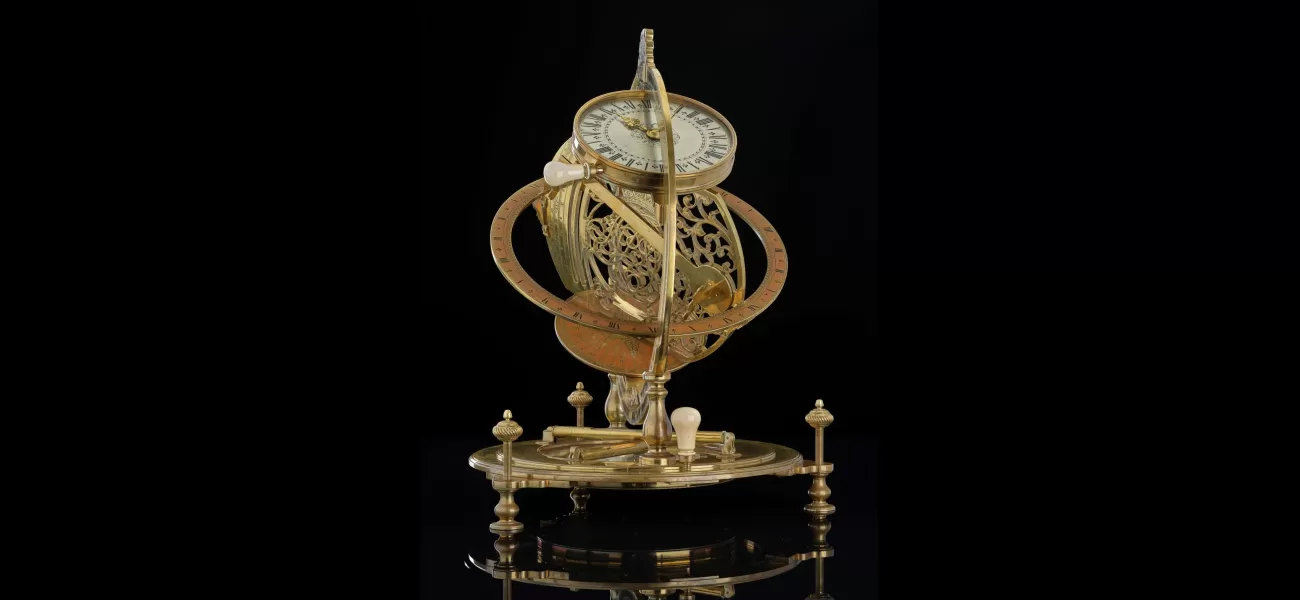A sundial from the 18th century, known as the Ilay Glynne dial, has been acquired by the nation and is considered a masterpiece.
18th century sundial, created for founder of RBS, acquired by nation after restoration.
July 25th 2024.

In the first half of the 18th century, a remarkable dial was created for the founder of the Royal Bank of Scotland, who held great political power during that time. This dial was used to measure the local time based on the position of the Sun. However, this exquisite piece, known as the Ilay Glynne dial, has now been acquired for the nation and is proudly on display at the National Museum of Scotland in Edinburgh, after undergoing extensive conservation work.
The Ilay Glynne dial was originally commissioned by Archibald Campbell, also known as the Earl of Ilay, who later became the 3rd Duke of Argyll. Ilay was a highly influential figure in Scotland after its union with England. He had significant control over royal patronage in Scotland and was responsible for managing Scottish affairs, making him one of the most politically powerful figures of his time. He also played a vital role as the founder and first governor of the Royal Bank of Scotland, with his portrait being featured on all RBS banknotes, and still seen on the £100 note today. Through his patronage, particularly in Scottish universities, Ilay became a major sponsor and promoter of the Scottish Enlightenment.
The mastermind behind the creation of the Ilay Glynne dial was Richard Glynne, a renowned maker of mathematical instruments and a member of the Clockmakers' Company. Glynne was closely connected to a growing community of British instrument makers and was known for producing exceptional quality instruments, of which the Ilay Glynne dial is the most significant surviving example. This type of dial was initially made for prominent figures such as Peter I of Russia and Prince George of Denmark, the consort of Queen Anne, suggesting that Ilay commissioned it from Glynne to showcase his reputation as a wealthy and influential nobleman.
The Ilay Glynne dial is a magnificent piece, made of brass and silvered brass, with the Ilay coat of arms at the top, complete with leopard supporters, a coronet, and motto. The central plate is decorated with the monogram 'AC' for Archibald Campbell, beneath an earl's coronet. According to Dr. Rebekah Higgitt from National Museums Scotland, the acquisition of this dial is a great addition to their collection, as it not only represents a significant scientific instrument but also holds strong connections to key developments in Scotland's history. It also showcases the breadth of their collection, being both a beautiful object and a symbol of Ilay's patronage of the arts, science, and learning.
The Ilay Glynne dial not only portrays the Earl of Ilay as a powerful and wealthy figure but also sheds light on his role as a patron of the arts, sciences, and learning. It is believed that Ilay's patronage played a crucial part in the development of the Scottish Enlightenment. He supported notable individuals such as philosopher Francis Hutcheson, chemist Joseph Black, astronomer Alexander Wilson, and poet Allan Ramsay, who all contributed to the emblematic works of 18th-century Scottish culture.
Apart from his involvement in promoting arts and sciences, Ilay also had a significant impact on Scotland's agriculture, infrastructure, fisheries, and linen trade. As the founder and governor of the Royal Bank of Scotland and the British Linen Company, he encouraged others to invest and improve these sectors. He also invested in overseas trading companies, including the African Company, East India Company, and South Seas Company, which profited from the exploitation of enslaved people. This serves as an important reminder of the key source of wealth that drove economic and cultural changes in 18th-century Scotland.
The acquisition of the Ilay Glynne dial by National Museums Scotland was made possible with the support of various funders, including the National Heritage Memorial Fund. According to Dr. Simon Thurley, the chair of the National Heritage Memorial Fund, this dial is not only a magnificent example of scientific achievement but also offers an opportunity to explore significant stories about scientific, intellectual, and cultural currents that led to the birth of the Scottish Enlightenment. To read more fascinating stories about Scottish culture, don't forget to subscribe to Scottish Field.
The Ilay Glynne dial was originally commissioned by Archibald Campbell, also known as the Earl of Ilay, who later became the 3rd Duke of Argyll. Ilay was a highly influential figure in Scotland after its union with England. He had significant control over royal patronage in Scotland and was responsible for managing Scottish affairs, making him one of the most politically powerful figures of his time. He also played a vital role as the founder and first governor of the Royal Bank of Scotland, with his portrait being featured on all RBS banknotes, and still seen on the £100 note today. Through his patronage, particularly in Scottish universities, Ilay became a major sponsor and promoter of the Scottish Enlightenment.
The mastermind behind the creation of the Ilay Glynne dial was Richard Glynne, a renowned maker of mathematical instruments and a member of the Clockmakers' Company. Glynne was closely connected to a growing community of British instrument makers and was known for producing exceptional quality instruments, of which the Ilay Glynne dial is the most significant surviving example. This type of dial was initially made for prominent figures such as Peter I of Russia and Prince George of Denmark, the consort of Queen Anne, suggesting that Ilay commissioned it from Glynne to showcase his reputation as a wealthy and influential nobleman.
The Ilay Glynne dial is a magnificent piece, made of brass and silvered brass, with the Ilay coat of arms at the top, complete with leopard supporters, a coronet, and motto. The central plate is decorated with the monogram 'AC' for Archibald Campbell, beneath an earl's coronet. According to Dr. Rebekah Higgitt from National Museums Scotland, the acquisition of this dial is a great addition to their collection, as it not only represents a significant scientific instrument but also holds strong connections to key developments in Scotland's history. It also showcases the breadth of their collection, being both a beautiful object and a symbol of Ilay's patronage of the arts, science, and learning.
The Ilay Glynne dial not only portrays the Earl of Ilay as a powerful and wealthy figure but also sheds light on his role as a patron of the arts, sciences, and learning. It is believed that Ilay's patronage played a crucial part in the development of the Scottish Enlightenment. He supported notable individuals such as philosopher Francis Hutcheson, chemist Joseph Black, astronomer Alexander Wilson, and poet Allan Ramsay, who all contributed to the emblematic works of 18th-century Scottish culture.
Apart from his involvement in promoting arts and sciences, Ilay also had a significant impact on Scotland's agriculture, infrastructure, fisheries, and linen trade. As the founder and governor of the Royal Bank of Scotland and the British Linen Company, he encouraged others to invest and improve these sectors. He also invested in overseas trading companies, including the African Company, East India Company, and South Seas Company, which profited from the exploitation of enslaved people. This serves as an important reminder of the key source of wealth that drove economic and cultural changes in 18th-century Scotland.
The acquisition of the Ilay Glynne dial by National Museums Scotland was made possible with the support of various funders, including the National Heritage Memorial Fund. According to Dr. Simon Thurley, the chair of the National Heritage Memorial Fund, this dial is not only a magnificent example of scientific achievement but also offers an opportunity to explore significant stories about scientific, intellectual, and cultural currents that led to the birth of the Scottish Enlightenment. To read more fascinating stories about Scottish culture, don't forget to subscribe to Scottish Field.
[This article has been trending online recently and has been generated with AI. Your feed is customized.]
[Generative AI is experimental.]
0
0
Submit Comment





